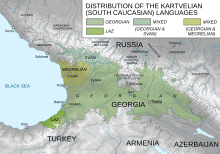Svans
This articleneeds additional citations forverification.(July 2024) |
 Distribution of the Svan language in relation to other Kartvelian (South Caucasian) languages. | |
| Total population | |
|---|---|
| c. 14,000[1]–80,000[2] | |
| Regions with significant populations | |
| Georgia | 14,000[1]–30,000[2] |
| Languages | |
| Svan,Georgian | |
| Religion | |
| Predominantly†Eastern Orthodox Christianity (Georgian Orthodox Church) | |
| Related ethnic groups | |
| Georgians,theLazandMingrelians | |
TheSvans(Svan:შვანარ,Shvanar;Georgian:სვანი,Svani) are an ethnic subgroup of theGeorgians(Kartvelians)[3][4][5][6][7]living mostly inSvaneti,a region in northwestGeorgia.They speak theSvan languageand are mostly bilingual also inGeorgian.Both these languages belong to theKartvelian (South Caucasian) language family.In the pre-1930 Soviet census, the Svans were categorized as a separate ethnic group (natsionalnost).[8]The self-designation of the Svan isMushüan,which is probably reflected in the ethnonymMisimianof the Classical authors.[9]
History
[edit]
| Part of a series on |
| Georgians ქართველები |
|---|
 |
| Nation |
| Georgia |
| Ancient Kartvelian people |
| Subgroups |
| Culture |
| Languages |
| Religion |
| Symbols |
| History of Georgia |
The Svans are usually identified with the Soani mentioned byGreekgeographerStrabo,who placed them more or less in the area still occupied by the modern-day Svans.[citation needed]
In the Russian Empire and early Soviet UnionMingreliansand Svans had their own census grouping, but were classified under the broader category of Georgian in the 1930s. They areGeorgian OrthodoxChristians, and were Christianized in the 4th–6th centuries. However, some remnants of pre-Christian beliefs have been maintained.Saint George(known asJgërægto the locals), apatron saintofGeorgia,is the most respected saint. The Svans have retained many of their old traditions, includingblood revenge,although this tradition has been declining over time and as law enforcement takes hold. Their families are small, and the husband is the head of his family. The Svan strongly respect the older women in families.
Language
[edit]Typically bilingual, they use bothGeorgianand their own, unwrittenSvan language.Prior to the 19th century, many Svans were monolingual, only knowing the Svan language.[10]
Genetics
[edit]The most commonY-chromosomal haplogroupamong the Svans isG2a(90%), in the second place is the Y-chromosomal haplogroupR1a(5%), in the third place is the Y-chromosomal haplogroupJ2a1(about 3%). Among mitochondrial haplogroupsH(17.9%),K(15.8%),W6(13%),T(9.24%),U1(7.61%),X2(6, 52%),U2(5.98%) are common haplogroups.[11]
Famous Svans
[edit]- Mathilda Gvarliani,fashion Model
- Temur Babluani(born 1948), film director, script writer, and actor
- Géla Babluani(born 1979), Georgian-French film director
- Mikheil Gelovani(1893–1956), actor who primarily portrayed Stalin
- Otar Ioseliani(1934–2023), film director in Georgia
- Mikheil Kurdiani(1954–2010), philologist, linguist, writer, poet and translator
- Sopho Gelovani(born 1984), singer
- Tariel Oniani(born 1952), mafia Boss
- Yaroslav Iosseliani(1912–1978), Soviet Navy submarine commander
- Nana Ioseliani(born 1962), chess player
- Otia Ioseliani(1930–2011), Georgian writer
- Egnate Gabliani (1881–1937), Georgian ethnographer
- Tengiz Kitovani(1938–2023), Georgian politician
References
[edit]- ^abProject, Joshua."Svanetian, Mushwan in Georgia".Retrieved18 August2017.
- ^ab"Svan/Udi/Tsova-Tush - DOBES".Retrieved18 August2017.
- ^Stephen F. Jones.Svans.World Culture Encyclopedia.Retrieved on March 13, 2011: «The Svans are one of the dozen or so traditionally recognized ethnic subgroups within the Georgian (Kartvelian) nation.»
- ^The SvansKevin TuiteUniversité de Montréal1992: «The Svans are one of the dozen or so traditionally recognized ethnic subgroups within the Georgian (Kartvelian) nation.»
- ^Britannica. Caucasian peoples:«The Caucasian peoples... The southerners, comprising the Georgians, the closely related Mingrelians and Laz, and the Svan, make up the Republic of Georgia and live in western Transcaucasia (the Laz live in Turkish territory).»
- ^R. Wixman.The Peoples of the USSR: An Ethnographic Handbook(p.181): «Svan... The Svanetians are one of the Kartvelian peoples of the Georgian SSR»
- ^Levinson, David. Ethnic Groups Worldwide: A Ready Reference Handbook. Phoenix: Oryx Press, 1998.p 35
- ^"Демоскоп Weekly - Приложение. Справочник статистических показателей".demoscope.ru.Retrieved18 August2017.
- ^History of Georgian Mountein Regions / R. Topchishvili. Available atThe National Parliamentary Library of Georgia
- ^Tuite, Kevin."Svan and its speakers"(PDF).Université de Montréal.p. 2.Archived(PDF)from the original on 23 October 2022.Retrieved8 December2022.
Up to the 19th century, many Svans were monolingual,
- ^Yardumian, Aram; Shengelia, Ramaz; Chitanava, David; et al. (2017)."Genetic diversity in S vaneti and its implications for the human settlement of the H ighland C aucasus".American Journal of Physical Anthropology.164(4): 837–852.doi:10.1002/ajpa.23324.ISSN0002-9483.


